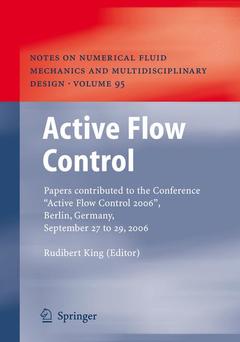Active Flow Control, 2007 Papers contributed to the Conference “Active Flow Control 2006”, Berlin, Germany, September 27 to 29, 2006 Notes on Numerical Fluid Mechanics and Multidisciplinary Design Series, Vol. 95
Langue : Anglais

The dramatically increasing requirements of mobility through road-, rail- and airborne transport systems in the future necessitate non-evolutionary impro- ments of transportation systems. Without severe implications concerning the environment or restrictions concerning the performance, these requirements will only be met by a concerted action of many disciplines. It is believed that with ACTIVE FLOW CONTROL a key technology exists to supply an important block in the mosaic to be laid in the pursuit of best and sustainable solutions. Manipulation of ?uid ?ows is highly advantageous in many cases. Aerodynamic or?uid?owsaroundorinsidebodies imposedrag,liftandmoments onthebody, removeor supply energy by convection. Flow-induced noise may be produced by the interaction of a body with the surrounding air. Moreover, the interaction with the body changes the state of the ?ow drastically. A neatly aligned laminar ?ow around a wing of an aircraft giving enough lift, can become highly irregular and separatedfrom the surface,with the result of a loss of lift. For cooling of - gines of transportand other systems highly irregular turbulent ?uid ?ows across the components are needed to guarantee a large heat transfer. In future engines of airplanes complying for example with the EU Vision 2020 an increased heat transfer, on the other hand, has to be avoided by all means in some parts of the engine. Turbine stages may be exposed here to extremely hot gases, needed for highe?ciency,whichwoulddestroythe blades. Inthis application,morelaminar ?ow regimes would be advantageous yielding a poorer heat transfer. Theirregular?owinacombustore. g.
The Taming of the Shrew: Why Is It so Difficult to Control Turbulence?.- The Taming of the Shrew: Why Is It so Difficult to Control Turbulence?.- Actuators.- Electromagnetic Control of Separated Flows Using Periodic Excitation with Different Wave Forms.- Pulsed Plasma Actuators for Active Flow Control at MAV Reynolds Numbers.- Experimental and Numerical Investigations of Boundary-Layer Influence Using Plasma-Actuators.- Designing Actuators for Active Separation Control Experiments on High-Lift Configurations.- Closed-Loop Active Flow Control Systems: Actuators.- State Estimation and Feature Extraction.- State Estimation of Transient Flow Fields Using Double Proper Orthogonal Decomposition (DPOD).- A Unified Feature Extraction Architecture.- Air Foils.- Control of Wing Vortices.- Towards Active Control of Leading Edge Stall by Means of Pneumatic Actuators.- Computational Investigation of Separation Control for High-Lift Airfoil Flows.- Steady and Oscillatory Flow Control Tests for Tilt Rotor Aircraft.- Cavities.- Reduced-Order Model-Based Feedback Control of Subsonic Cavity Flows — An Experimental Approach.- Supersonic Cavity Response to Open-Loop Forcing.- Bluff Bodies.- Active Drag Control for a Generic Car Model.- Continuous Mode Interpolation for Control-Oriented Models of Fluid Flow.- Turbomachines and Combustors.- Active Management of Entrainment and Streamwise Vortices in an Incompressible Jet.- Active Control to Improve the Aerodynamic Performance and Reduce the Tip Clearance Noise of Axial Turbomachines with Steady Air Injection into the Tip Clearance Gap.- Optimal Flow Control and Numerical Studies.- Drag Minimization of the Cylinder Wake by Trust-Region Proper Orthogonal Decomposition.- Flow Control on the Basis of a Featflow-Matlab Coupling.- On the Choiceof the Cost Functional for Optimal Vortex Reduction for Instationary Flows.- Flow Control with Regularized State Constraints.- Closed-Loop Flow Control.- Feedback Control Applied to the Bluff Body Wake.- Active Blade Tone Control in Axial Turbomachines by Flow Induced Secondary Sources in the Blade Tip Regime.- Phase-Shift Control of Combustion Instability Using (Combined) Secondary Fuel Injection and Acoustic Forcing.- Vortex Models for Feedback Stabilization of Wake Flows.
State-of-the-art flow control Well balanced combination of theoretical and experimental results Combines new developments in actuator technology, sensing, robust and optimal open- and closed-loop control and model reduction for control
Date de parution : 08-2016
Ouvrage de 442 p.
15.5x23.5 cm
Date de parution : 05-2007
Ouvrage de 442 p.
15.5x23.5 cm
Thèmes d’Active Flow Control :
© 2024 LAVOISIER S.A.S.



